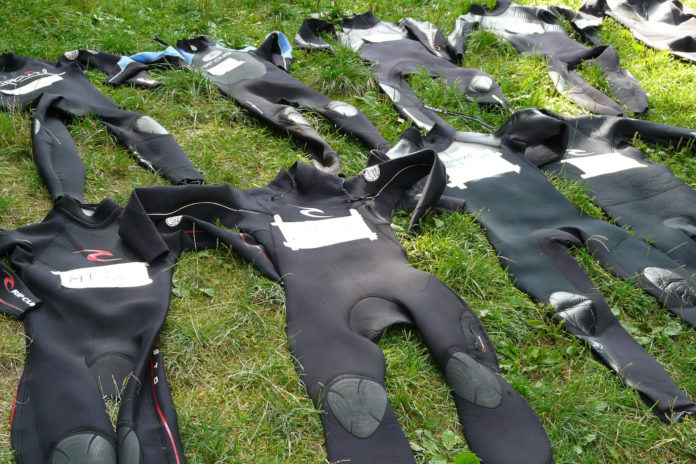
Anyone that has ever worn a wetsuit knows how awkward they are to get into. And once you are wearing it, they certainly are not the most flattering piece of clothing. Despite this, surfers, swimmers, snorkelers, and scuba divers use them regularly. So what does a wetsuit do?
What Does a Wetsuit Do?
In short, a wetsuit keeps you warm in the water. Because water is far denser than air, humans lose heat 20 – 25 times faster in water than we do in air. Wetsuits work because they slow the cooling process when in the water.
Physics dictates that if we place an object in water that is cooler than the object itself, it will over time equalize the temperature of the water and the object. This works both ways. If the object is large enough it can heat or cool the water. Placing an ice cube in your drink will cool the drink.
In correct terminology, Convection is the transfer of heat by the movement of a fluid (liquid or gas) between areas of different temperature. (source)
This is precisely what a wetsuit slows. By reducing movement between areas of different temperatures, we do not get cold as fast as we would without a wetsuit.
The ocean is a huge body of water and our body would not be able to raise its temperature, meaning we would over time cool down to be the same temperature as the water around us. The greater the difference, the faster the initial cooling. This is why you get cold faster in really cold water.
Our body temperature has to be kept very close to 37° Celsius (98.6° Fahrenheit) in order for us to not become hypothermic. If the water was the same temperature we would never feel cold. On the contrary, water that is 27° C is cold enough to make us hypothermic if we spend enough time in it.
Now, what a wetsuit does, is trap a small amount of water near your body. Your body will heat this small amount of water with your body temperature. The neoprene insulation layer also slows down the cooling of that water.
An ill-fitted wetsuit will, therefore, do very little to keep you warm. If the water can flow freely in and out of a wetsuit, you are essentially water-cooling yourself by means of convection.
Surfing vs Swimming Wetsuits
Surfers and divers have different requirements for wetsuits.
Surfers and swimmers need flexibility in their suits allowing for more mobility. These wetsuits are designed for being on the surface. They do not compress as well when submerged and usually feature a coating that protects from the wind and glides through the water easier.
Divers, on the other hand, do not need protection from the wind. They need their suits to be compressible so that they still provide ample protection at depth when the neoprene material compresses under the pressure. Mobility is also less of a requirement since scuba divers are less active during their dives. They need their wetsuits to insulate for longer immersion times.
Learn more about wetsuits in this Ultimate Guide to Wetsuits
Tips for Getting into a Wetsuit
Donning a wetsuit is the bane of any diver. It takes time; is awkward, cumbersome, and uncomfortable. We have all performed the “wetsuit dance” trying to get into our wetsuits for the first time!
Here are a few techniques that can help you get into a wetsuit.
First of all, let’s talk about the order. Make sure you have the wetsuit rotated the correct way. Most wetsuits are worn with the zipper in the back, however, there are some which feature a front zipper.
So, once you have rotated it the correct way, get your suit on from the bottom up. It helps to sit down with a long suit. Once your foot is through, move the neoprene up so that the part of the wetsuit that should cover your ankle is in the correct position. Repeat this up your leg until one leg is done up to above your knee.
Now repeat with your other leg. Then it’s time to stand up and continuously pull the suit up a few centimeters / inches at the time. Don’t try to get it over your hips too early!
Once you have pulled it all the way up to your waist, it’s time to put your arms in. I recommend waiting until the last possible moment to do this as overheating can be an issue on the surface.
In a similar fashion pull the suit over your arms one at a time past your elbows. Then flex your shoulders back to get the rest of the suit around your chest and over your shoulders. Phew!
Pro Tip: You can put your foot in a plastic bag and it will slide through your wetsuit’s leg much easier.
Let’s Wrap It Up
What does a wetsuit do? It significantly slows down the cooling of your body by preventing convection. Wetsuits are great as they allow surfers to hit waves for longer and divers to explore cooler waters for longer. Without wetsuits, both surfing and diving would be far less enjoyable and endurable in temperate water.